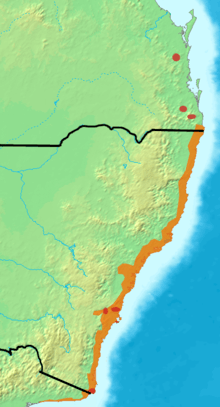Eastern bristlebird
| Eastern bristlebird | |
|---|---|
| Scientific classification | |
| Kingdom: | Animalia |
| Phylum: | Chordata |
| Class: | Aves |
| Order: | Passeriformes |
| Family: | Dasyornithidae |
| Genus: | Dasyornis |
| Species: | D. brachypterus |
| Binomial name | |
| Dasyornis brachypterus (Latham, 1801) | |
 | |
| Distribution of the eastern bristlebird Orange Indicates Possible Range | |
The eastern bristlebird (Dasyornis brachypterus) is a species of bird in the bristlebird family Dasyornithidae. It is endemic to Australia. Its natural habitats are temperate forests, temperate shrubland, and temperate grassland. It is threatened by habitat loss.
Distribution and habitat
The eastern bristlebird is very territorial and will often use a distinct, loud melodic song to mark its territory.[2]
Surveys have found the bird prefers to live in small, localised populations.[2] An isolated colony was found in the Conondale Range in southeastern Queensland in the 1980s.[2] Eastern bristlebirds build their nests on the ground in areas of dense, clumped grasses.[2]
Important Bird Areas
Sites identified by BirdLife International as being important for eastern bristlebird conservation are the Scenic Rim on the border between southern Queensland and northern New South Wales, Budderoo and Barren Grounds, Jervis Bay, and Nadgee to Mallacoota Inlet straddling the border between south-eastern New South Wales and eastern Victoria.[3]
Conservation status
- Australia
Eastern bristlebirds are listed as endangered on the Australian Environment Protection and Biodiversity Conservation Act 1999.
- New South Wales
The eastern bristlebird is listed as endangered under the Threatened Species Conservation Act 1995.[4]
- Queensland
The eastern bristlebird is listed as endangered under the Nature Conservation Act 1992 .[5]
- Victoria
On the 2007 advisory list of threatened vertebrate fauna in Victoria, the eastern bristlebird is listed as endangered.[6] It is listed as threatened on the Victorian Flora and Fauna Guarantee Act (1988),[7] under which an Action Statement for the recovery and management of the species has been prepared.[7]
See also
References
- ↑ BirdLife International (2013). "Dasyornis brachypterus". IUCN Red List of Threatened Species. Version 2013.2. International Union for Conservation of Nature. Retrieved 26 November 2013.
- 1 2 3 4 "Eastern Bristlebird". Department of Environment and Resource Management. The State of Queensland. 3 September 2009. Retrieved 23 December 2009.
- ↑ "Eastern Bristlebird". Important Bird Areas. BirdLife International. 2012. Archived from the original on 2007-07-10. Retrieved 2012-11-01.
- ↑ "NSW Threatened Species Profile". NSW Office of Environment & Heritage. Retrieved 18 August 2016.
- ↑ "Endangered". Department of Environment and Resource Management. The State of Queensland. 3 September 2009. Retrieved 23 December 2009.
- ↑ Victorian Department of Sustainability and Environment (2007). Advisory List of Threatened Vertebrate Fauna in Victoria - 2007. East Melbourne, Victoria: Department of Sustainability and Environment. p. 15. ISBN 978-1-74208-039-0.
- 1 2 Listed Taxa, Communities and Potentially Threatening Processes Archived July 18, 2005, at the Wayback Machine. Department of Sustainability and Environment, Victoria.
External links
- BirdLife Species Factsheet.
- Image at ADW
- Australian Government Threatened Species Profile
- NSW Threatened Species Profile
